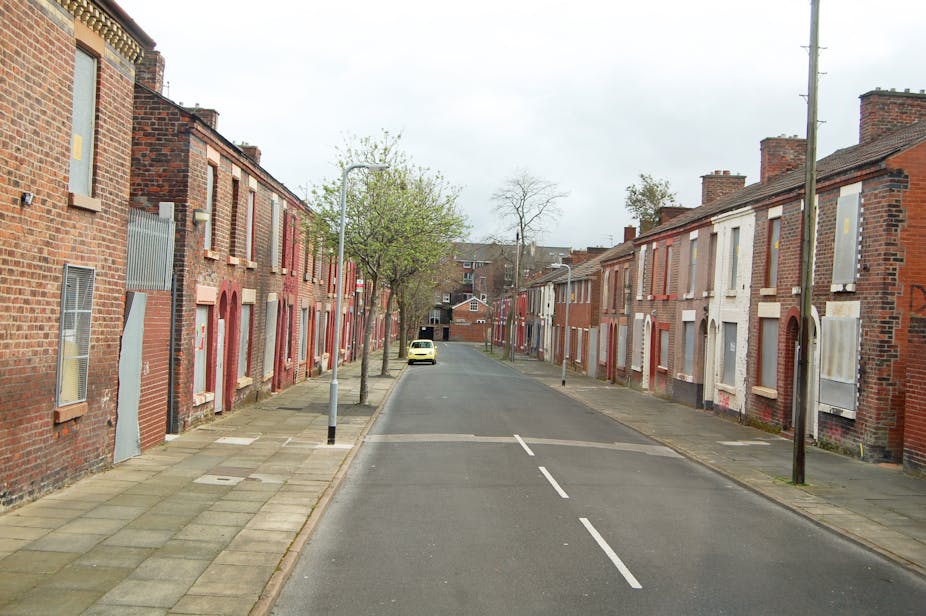The conventional image of suburbia is one of bland affluence and social homogeneity. Suburbs are where the middle classes aspire to make their nests. They are the idealised safe havens for raising children and growing old. They are where white people migrate to flee ethnic diversity.
In the United States suburbia has sprawled into vast expansions of the city, the suburbs become synonymous with the American dream. Homo Americanus’s natural habitat is supposedly the leafy suburban neighbourhood with manicured lawns and white picket fences.
So ingrained is the association between wealth and the outer circles of a city that the word “suburban” has long since become shorthand for bourgeois materialism – and an inviting target for social critics. Suburbia is where nothing happens. “Same old boring Sunday morning, old men out washing their cars,” as the song Sound of the Suburbs would have it.
For real life and social authenticity you must descend into the inner city, the locus of poverty, ethnic ghettos, human struggle and cultural vibrancy. To speak of suburban poverty is something of an oxymoron. Or is it?
The 21st-century poor
Not any longer. Emerging evidence of decentralised deprivation, particularly in the US, suggests that social commentators may need to start searching for a new metaphor. The rise of suburban poverty has been highlighted as one of the most significant trends that may come to characterise 21st-century cities.
Recent research by the Brookings Institute of Washington DC, for example, finds in American cities as varied as San Francisco, Cleveland, Chicago and Seattle “a series of communities in transition … from outposts of the middle class to symbols of modern American poverty”. Suburbia is now “home to the largest and fastest-growing poor population in the country and more than half of the metropolitan poor”.
This side of the pond
The same thing appears to have been happening in the UK. Research by the London-based Smith Institute found the same trend in England and Wales. It found 6.8m people living in poverty in the suburbs, comprising 57% of all those in poverty. It also found that this was rising.
Between 2001 and 2011, the institute reports that the number of people living in the suburbs experiencing above-average levels of poverty rose by 34%. It found a 25% rise in the number of unemployed households, compared to 9% elsewhere. And in the eight biggest English cities – London, Leeds, Birmingham, Newcastle, Liverpool, Manchester, Sheffield and Bristol – the suburbs had become poorer relative to inner-city areas over the same time period.

No equivalent study had looked north of the border. This is an intriguing omission, particularly given the closely drawn outcome of the recent referendum for Scottish independence. A big question in that debate was whether and to what extent Scotland is different.
Glasgow calling
I have been part of a research team that has sought to remedy this, initially by looking at Glasgow. We have sought to improve on what has been done before by developing new methods to overcome the problem of gauging whether we are observing genuine change in the urban distribution of poverty rather than random churn in population movements. We are currently applying this to Edinburgh, Aberdeen, Dundee and Inverness and are likely to look to England and Wales in due course, so it will be interesting to see to what extent our findings match those of the Smith Institute.
In our study of Glasgow, it is worth pointing out that much of the poverty concentrates on housing estates on the edges of the city. There are one or two areas of inner-city poverty, but nothing equivalent to, say, London. Yet the wealthier suburbs are also concentrated in the outer areas. To avoid getting into what counts as suburban, which is actually much more complex than you might think, we focused on whether the indicators of poverty were moving outwards.
Sure enough, poverty became noticeably less centralised in Glasgow between 2001 and 2011. The concentration of people on income support in outer areas rose 27%, while it rose 59% for those on incapacity benefit and 48% for those on Job Seekers’ Allowance.

This doesn’t mean that the suburbs of Glasgow are likely to become the new ghettos of deprivation any time soon. Poverty is still largely concentrated in the inner cities and former council estates. But the results do provide the first evidence that the same trend that has been witnessed in England, Wales and the US is also happening in Scotland.
Why does all this matter? Welfare policy and regeneration frameworks have historically been geared towards inner cities. Fragmentation and dispersal of poverty could raise new challenges for policy developers and additional problems of social isolation for those unlucky enough to find themselves poor in suburbia. Area-based policies, for example for support services, are most effective if those in greatest need are concentrated in particular sectors of the city.
This is therefore something that needs to be taken much more seriously by those who decide how poverty should be tackled. The more that poverty finds new places to live, the more that anti-poverty policies have to move to keep up with it. The battle against poverty in the 21st century may need to take on very different forms to what it was before.

